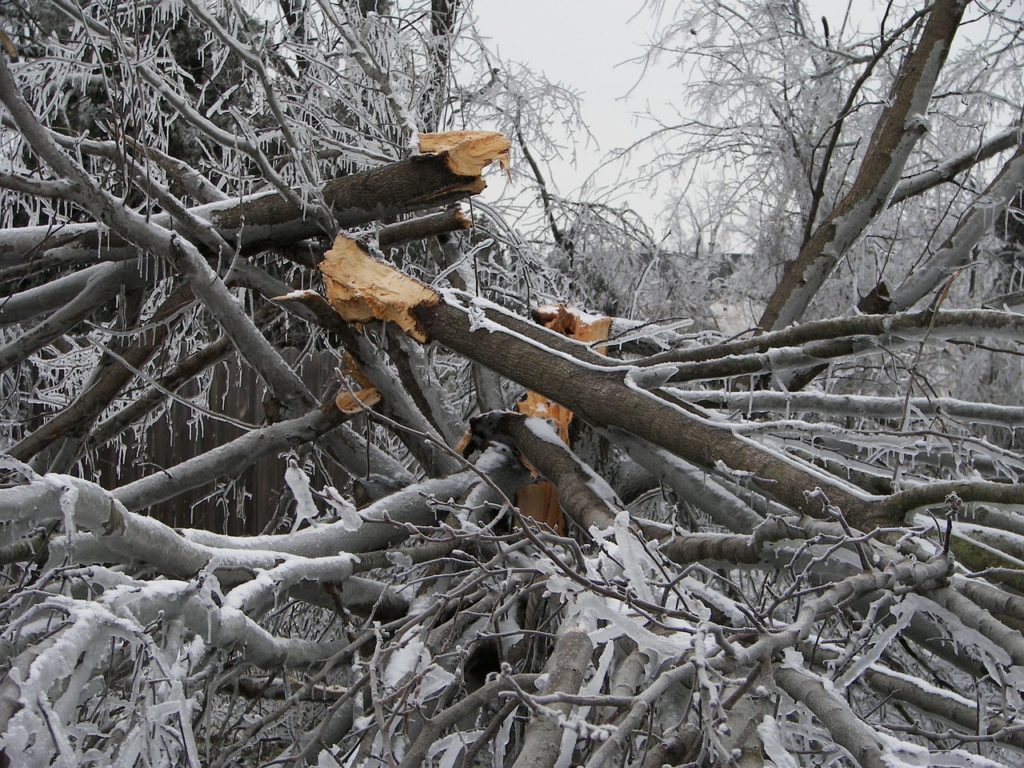Introduction
During the winter months, frigid temperatures and heavy winds can combine to produce fierce storms. Winter storms can feature abundant precipitation – often in the form of ice or snow – extreme cold, and strong winds. The intensity of winter storms varies, with some resulting in whiteout conditions. While these storms are frequently problematic for humans, they are especially concerning for trees and shrubs. Plants that are subjected to winter storms may incur low temperature injuries, or breakages caused by significant snow or ice loading. To ensure the safety of your landscape or home, it is important to inspect your plants for damage following one of these events.
Check Your Surroundings
Before conducting an assessment of your plants, always be sure to inspect your surroundings for environmental hazards. Blizzards can cause utility lines to be ripped from their supporting poles, exposing the live wires. Be wary of approaching any collapsed wires, as they may still be active. Additionally, survey the area for branches that have cracked or broken, and are suspended in nearby trees. A sudden gust of wind or a shifting of the tree’s weight can cause the branch to plummet to the ground. As such, trees of this nature should be avoided. Contact a certified arborist to have the branch promptly removed.
Assess Your Plants for Storm Damage
Inspect your plants for visible signs of storm damage. You may begin by examining the base of your plants to determine if cracks, holes, splits, or cavities have formed in the trunk. These can render the plant more susceptible to infiltration from disease pathogens and insects. Moreover, these types of injuries to the trunk can promote wood decay. If the decay becomes extensive in the trunk, it can cause the plant to fail. When assessing the base of a plant, also check for root heaving. If a plant’s root system has breached the surface of the soil, it may indicate that the structural integrity of the plant has been compromised. In such an event, the plant may require removal. If a plant has sustained an injury on its trunk or to its root system, contact a certified arborist to ascertain the extent of the damage. Be wary of injured plants, as they may be hazardous, and could founder at any time.
Once the base of a plant has been thoroughly evaluated, observe the plant’s positioning. If a plant is leaning considerably to one side, it could denote that the plant is unstable, and on the verge of toppling over. If the base of a plant appears intact, and its positioning has not been altered, proceed to study to its branches. Breakages due to ice or snow loading are common during blizzards. Evergreens, such as arbovitae, junipers, and yews, are especially prone to this type of winter storm injury. If a plant has sustained an injury, determine if it remains healthy. Damaged plants that have retained more than 50% of their crown will likely recover from most branch injuries.
Pruning to Remove Defective Branches
Plants may be pruned to remove branch defects, and prevent further damage to the crown. Pruning also improves plant vigor, reduces the potential for decay, and helps to safeguard plants from disease pathogens and insects. Apply pruning cuts at the branch collar, and avoid slicing into the plant’s trunk. Do not remove more than 1/3 of a plant’s crown at any one time. Tree topping is also not advisable, as it destroys the branch architecture of the tree. If a plant requires the extraction of a lofty branch, or the operation of a chainsaw, contact a certified arborist to perform the task.
Dislodging Snow from Branches
On small trees and shrubs, roughly handling branches that have accumulated snow or ice can cause them to snap. If snow or ice must be dislodged from a branch, gently push upwards on the branch to relieve it of the additional weight.
Mending a Split Trunk or Branch
Branches with minor splits will generally callus over the wound. Severe splits on larger branches or a plant’s trunk are more challenging to repair. The installation of cables and braces may enable the plant to recover. If the split is too significant, the plant may need to be removed. If a branch or tree has developed a split, contact a certified arborist to discern whether or not it may be retained.


